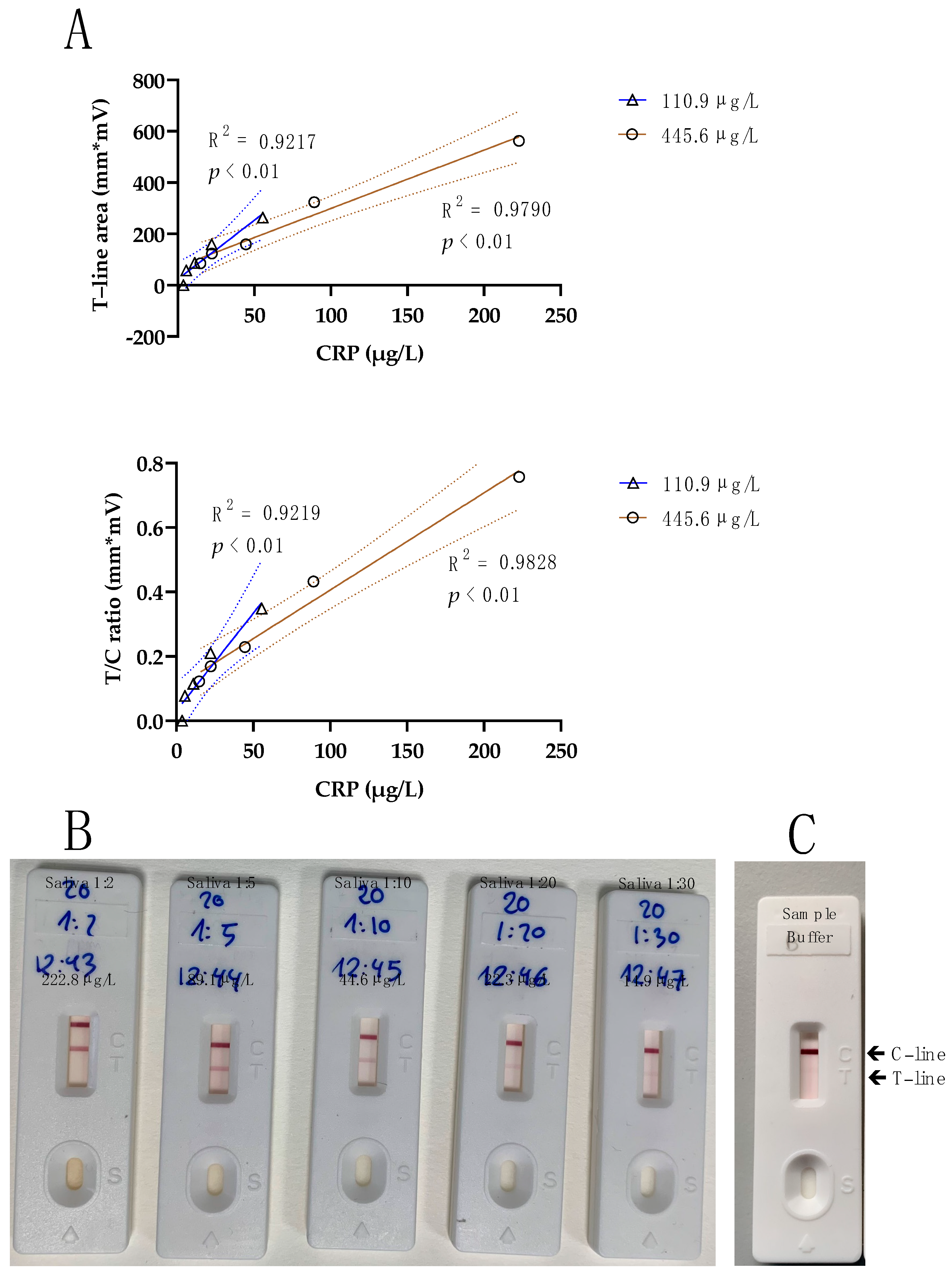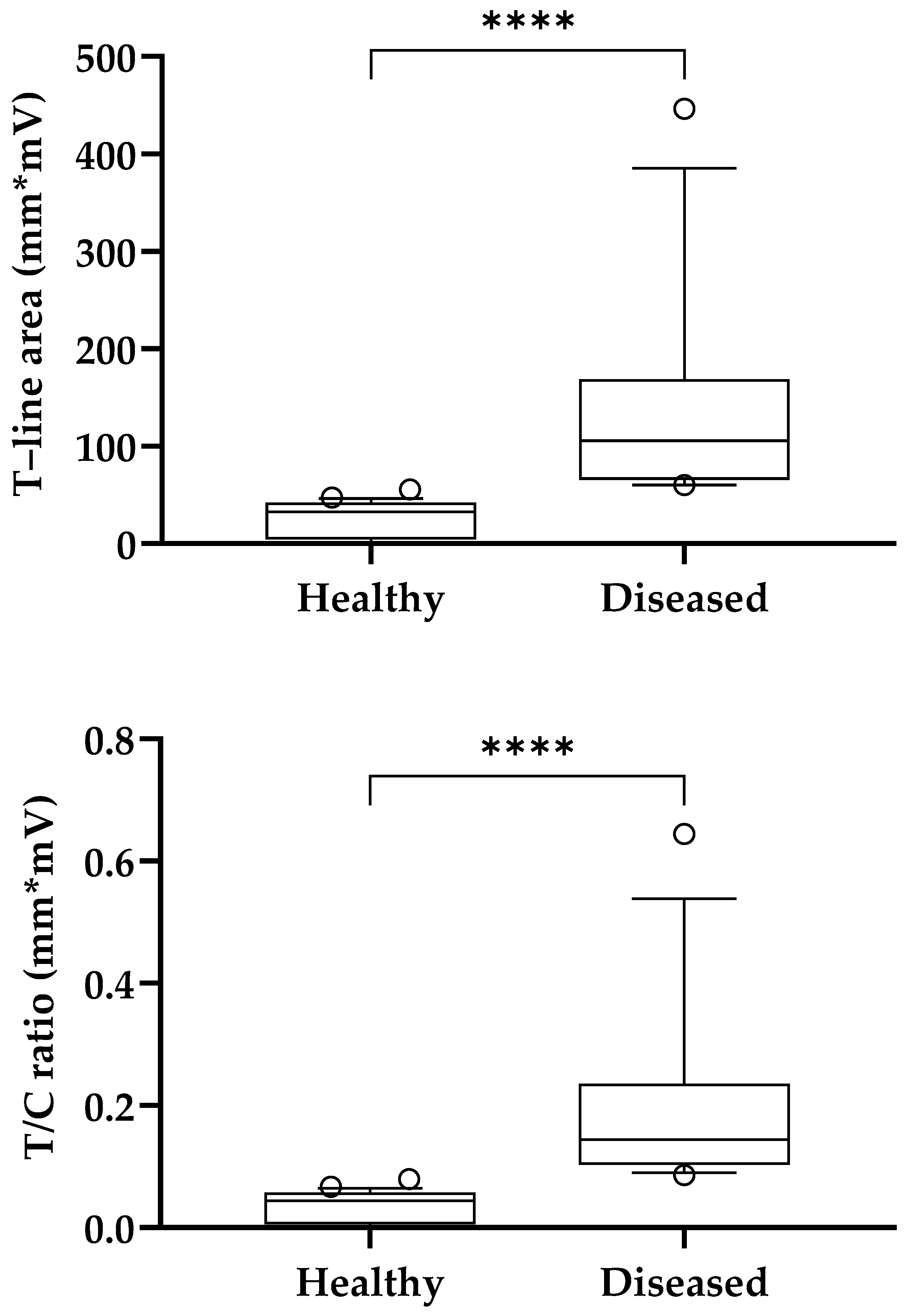Towards the Measurement of Acute-Phase Proteins in Saliva in Farm Conditions: Development and Validation of a Lateral Flow Assay for the Measurement of C-Reactive Protein in Pigs
Abstract
1. Introduction
2. Materials and Methods
2.1. Monoclonal Antibody Culture and Purification
2.2. Development of the LFIA for the Measurement of CRP in Porcine Saliva
2.2.1. Preparation of Gold Nanoparticles and Gold Conjugates
2.2.2. Preparation of LFIA Devices
2.3. Protocol Assay
2.4. Animals and Saliva Samples
2.5. Validation Protocol for LFIA
2.5.1. Optimization of Reading Time
2.5.2. Accuracy
2.5.3. Imprecision
2.5.4. Overlap Performance
2.6. Statistical Approach
3. Results
3.1. Optimization of the GNP–mAb Conjugate
3.2. Optimization of Reading Time
3.3. Accuracy
3.4. Imprecision
3.5. Overlap Performance
4. Discussion
5. Conclusions
Author Contributions
Funding
Institutional Review Board Statement
Informed Consent Statement
Data Availability Statement
Conflicts of Interest
References
- European Commission. Attitudes of Europeans towards Animal Welfare. In Special Eurobarometer; European Commission: Brussels, Belgium, 2015; Volume 442. [Google Scholar]
- Gyles, C. Escherichia coli Verotoxin and Other Cytotoxins. In Escherichia coli in Domestic Animals and Humans; Gyles, C., Ed.; CAB International: Wallingford, UK, 1994; pp. 151–170. [Google Scholar]
- Schokker, D.; Zhang, J.; Vastenhouw, S.A.; Heilig, H.G.H.J.; Smidt, H.; Rebel, J.M.J.; Smits, M.A. Long-Lasting Effects of Early-Life Antibiotic Treatment and Routine Animal Handling on Gut Microbiota Composition and Immune System in Pigs. PLoS ONE 2015, 10, e0116523. [Google Scholar] [CrossRef] [PubMed]
- Tran, T.H.T.; Everaert, N.; Bindelle, J. Review on the Effects of Potential Prebiotics on Controlling Intestinal Enteropathogens Salmonella and Escherichia Coli in Pig Production. J. Anim. Physiol. Anim. Nutr. 2018, 102, 17–32. [Google Scholar] [CrossRef]
- Pohanka, M. Diagnoses Based on C-Reactive Protein Point-of-Care Tests. Biosensors 2022, 12, 344. [Google Scholar] [CrossRef]
- Cerón, J. Acute Phase Proteins, Saliva and Education in Laboratory Science: An Update and Some Reflections. BMC Vet. Res. 2019, 15, 197. [Google Scholar] [CrossRef]
- Borse, V.; Srivastava, R. Process Parameter Optimization for Lateral Flow Immunosensing. Mater. Sci. Energy Technol. 2019, 2, 434–441. [Google Scholar] [CrossRef]
- Posthuma-Trumpie, G.A.; Korf, J.; van Amerongen, A. Lateral Flow (Immuno)Assay: Its Strengths, Weaknesses, Opportunities and Threats. A Literature Survey. Anal. Bioanal. Chem. 2009, 393, 569–582. [Google Scholar] [CrossRef] [PubMed]
- Sajid, M.; Kawde, A.-N.; Daud, M. Designs, Formats and Applications of Lateral Flow Assay: A Literature Review. J. Saudi Chem. Soc. 2015, 19, 689–705. [Google Scholar] [CrossRef]
- Oh, Y.K.; Joung, H.-A.; Han, H.S.; Suk, H.-J.; Kim, M.-G. A Three-Line Lateral Flow Assay Strip for the Measurement of C-Reactive Protein Covering a Broad Physiological Concentration Range in Human Sera. Biosens. Bioelectron. 2014, 61, 285–289. [Google Scholar] [CrossRef] [PubMed]
- Wu, R.; Zhou, S.; Chen, T.; Li, J.; Shen, H.; Chai, Y.; Li, L.S. Quantitative and Rapid Detection of C-Reactive Protein Using Quantum Dot-Based Lateral Flow Test Strip. Anal. Chim. Acta 2018, 1008, 1–7. [Google Scholar] [CrossRef]
- Fan, L.; Yan, W.; Chen, Q.; Tan, F.; Tang, Y.; Han, H.; Yu, R.; Xie, N.; Gao, S.; Chen, W.; et al. One-Component Dual-Readout Aggregation-Induced Emission Nanobeads for Qualitative and Quantitative Detection of C-Reactive Protein at the Point of Care. Anal. Chem. 2024, 96, 401–408. [Google Scholar] [CrossRef] [PubMed]
- Plickert, H.D.; Einspanier, R.; Arndt, G.; Brunnberg, L.; Kohn, B. Evaluation of a Point-of-care Test for Canine C-reactive Protein. Vet. Clin. Pathol. 2011, 40, 384–388. [Google Scholar] [CrossRef] [PubMed]
- Choi, J.; Yoo, M.; Jang, Y.-J.; Na, B.; Seo, S.; Moon, J.; Lee, J.; Seol, J. Development and Clinical Evaluation of a Quantitative Fluorescent Immunoassay for Detecting Canine CRP. Int. J. Vet. Sci. Med. 2023, 11, 87–93. [Google Scholar] [CrossRef]
- Franco-Martínez, L.; Castillo-Felipe, C. Saliva as a Non-Invasive Sample: Pros and Cons. In Saliva in Health and Disease; Tvarijonaviciute, A., Martínez-Subiela, S., López-Jornet, P., Lamy, E., Eds.; Springer International Publishing: Cham, Switzerland, 2020; pp. 49–65. [Google Scholar]
- Parra, M.D.; Tecles, F.; Martínez-Subiela, S.; Cerón, J.J. C-Reactive Protein Measurement in Canine Saliva. J. Vet. Diagn. Investig. 2005, 17, 139–144. [Google Scholar] [CrossRef]
- Cerón, J.; Contreras-Aguilar, M.; Escribano, D.; Martínez-Miró, S.; López-Martínez, M.; Ortín-Bustillo, A.; Franco-Martínez, L.; Rubio, C.; Muñoz-Prieto, A.; Tvarijonaviciute, A.; et al. Basics for the Potential Use of Saliva to Evaluate Stress, Inflammation, Immune System, and Redox Homeostasis in Pigs. BMC Vet. Res. 2022, 18, 81. [Google Scholar] [CrossRef] [PubMed]
- Cho, Y.-R.; Oh, Y.-I.; Song, G.-H.; Kim, Y.J.; Seo, K.-W. Comparative Analysis of C-Reactive Protein Levels in the Saliva and Serum of Dogs with Various Diseases. Animals 2020, 10, 1042. [Google Scholar] [CrossRef] [PubMed]
- Pay, J.B.; Shaw, A.M. Towards Salivary C-Reactive Protein as a Viable Biomarker of Systemic Inflammation. Clin. Biochem. 2019, 68, 1–8. [Google Scholar] [CrossRef] [PubMed]
- Ortín-Bustillo, A.; Llamas, E.; López-Martínez, M.J.; Martínez-Subiela, S.; Tvarijonaviciute, A.; Franco-Martínez, L.; Cerón, J.J.; Muñoz-Prieto, A. Validation of a New Assay for the Measurent of CRP in the Saliva of Pigs. In Proceedings of the 27th International Pig Veterinary Society Congress 15th European Symposium of Porcine Health Management, Leipzig, Germany, 4 June 2024. [Google Scholar]
- Kuhlmann, I.; Kurth, W.; Ruhdel, I. Monoclonal Antibodies: In Vivo- and in Vitro-Production in Laboratory Scale with Consideration of the Legal Aspects of Animal Protection. Altern. Anim. Exp. 1989, 6, 12–26. [Google Scholar] [CrossRef]
- Yokoyama, W.M.; Christensen, M.; Santos, G.D.; Miller, D.; Ho, J.; Wu, T.; Dziegelewski, M.; Neethling, F.A. Production of monoclonal antibodies. Curr. Protoc. Immunol. 2013, 102, 2.5.1–2.5.29. [Google Scholar] [CrossRef] [PubMed]
- Anfossi, L.; Di Nardo, F.; Profiti, M.; Nogarol, C.; Cavalera, S.; Baggiani, C.; Giovannoli, C.; Spano, G.; Ferroglio, E.; Mignone, W.; et al. A Versatile and Sensitive Lateral Flow Immunoassay for the Rapid Diagnosis of Visceral Leishmaniasis. Anal. Bioanal. Chem. 2018, 410, 4123–4134. [Google Scholar] [CrossRef] [PubMed]
- Roda, A.; Cavalera, S.; Di Nardo, F.; Calabria, D.; Rosati, S.; Simoni, P.; Colitti, B.; Baggiani, C.; Roda, M.; Anfossi, L. Dual Lateral Flow Optical/Chemiluminescence Immunosensors for the Rapid Detection of Salivary and Serum IgA in Patients with COVID-19 Disease. Biosens. Bioelectron. 2021, 172, 112765. [Google Scholar] [CrossRef]
- Trakoolwilaiwan, T.; Takeuchi, Y.; Leung, T.S.; Sebek, M.; Storozhuk, L.; Nguyen, L.; Tung, L.D.; Thanh, N.T.K. Development of a Thermochromic Lateral Flow Assay to Improve Sensitivity for Dengue Virus Serotype 2 NS1 Detection. Nanoscale 2023, 15, 12915–12925. [Google Scholar] [CrossRef] [PubMed]
- Di Nardo, F.; Chiarello, M.; Cavalera, S.; Baggiani, C.; Anfossi, L. Ten Years of Lateral Flow Immunoassay Technique Applications: Trends, Challenges and Future Perspectives. Sensors 2021, 21, 5185. [Google Scholar] [CrossRef] [PubMed]
- Railey, A.F.; Adamson, D.; Simmons, H.L.; Rushton, J. Economics of Reducing Response Time to Foreign-Animal Disease in the United States with Point-of-Care Diagnostic Tests. Prev. Vet. Med. 2024, 230, 106284. [Google Scholar] [CrossRef]
- Wu, L.; Liang, J.; Teng, P.; Du, Y.; He, Y.; Liao, S.; Wang, J.; Zhang, X.; Wang, Z.; Zeng, T.; et al. A Filter Pad Design-Based Multiplexed Lateral Flow Immunoassay for Rapid Simultaneous Detection of PDCoV, TGEV, and PEDV in Swine Feces. Talanta 2024, 280, 126712. [Google Scholar] [CrossRef] [PubMed]
- You, D.; Xu, T.; Huang, B.-Z.; Zhu, L.; Wu, F.; Deng, L.-S.; Liu, Z.-Y.; Duan, J.-Q.; Wang, Y.-M.; Ge, L.-P.; et al. Rapid, Sensitive, and Visual Detection of Swine Japanese Encephalitis Virus with a One-Pot RPA-CRISPR/EsCas13d-Based Dual Readout Portable Platform. Int. J. Biol. Macromol. 2024, 277, 134151. [Google Scholar] [CrossRef] [PubMed]
- Storms, S.M.; Shisler, J.; Nguyen, T.H.; Zuckermann, F.A.; Lowe, J.F. Lateral Flow Paired with RT-LAMP: A Speedy Solution for Influenza A Virus Detection in Swine. Vet. Microbiol. 2024, 296, 110174. [Google Scholar] [CrossRef] [PubMed]
- Aira, C.; González-García, G.; Martínez-Cano, J.; de la Roja, N.; Giammarioli, M.; Feliziani, F.; Šteingolde, Ž.; Buitkuviene, J.; Václavek, P.; Glišić, D.; et al. Simultaneous Detection of Antigen and Antibodies of African Swine Fever in a Novel Combo Lateral Flow Assay. Vaccines 2024, 12, 307. [Google Scholar] [CrossRef] [PubMed]
- Tiwari, G.; Tiwari, R. Bioanalytical Method Validation: An Updated Review. Pharm. Methods 2010, 1, 25–38. [Google Scholar] [CrossRef]
- Wang, Z.; Yu, W.; Xie, R.; Yang, S.; Chen, A. A Strip of Lateral Flow Gene Assay Using Gold Nanoparticles for Point-of-Care Diagnosis of African Swine Fever Virus in Limited Environment. Anal. Bioanal. Chem. 2021, 413, 4665–4672. [Google Scholar] [CrossRef]
- Ssematimba, A.; Malladi, S.; Bonney, P.J.; Flores-Figueroa, C.; Muñoz-Aguayo, J.; Halvorson, D.A.; Cardona, C.J. Quantifying the Effect of Swab Pool Size on the Detection of Influenza A Viruses in Broiler Chickens and Its Implications for Surveillance. BMC Vet. Res. 2018, 14, 265. [Google Scholar] [CrossRef]
- Manessis, G.; Gelasakis, A.I.; Bossis, I. Point-of-Care Diagnostics for Farm Animal Diseases: From Biosensors to Integrated Lab-on-Chip Devices. Biosensors 2022, 12, 455. [Google Scholar] [CrossRef] [PubMed]
- Cappai, S.; Loi, F.; Rolesu, S.; Coccollone, A.; Laddomada, A.; Sgarangella, F.; Masala, S.; Bitti, G.; Floris, V.; Desini, P. Evaluation of the Cost-Effectiveness of ASF Detection with or without the Use of on-Field Tests in Different Scenarios, in Sardinia. J. Vet. Sci. 2020, 21, e14. [Google Scholar] [CrossRef] [PubMed]
- Zhang, J.; Chai, F.; Li, J.; Wang, S.; Zhang, S.; Li, F.; Liang, A.; Luo, A.; Wang, D.; Jiang, X. Weakly Ionized Gold Nanoparticles Amplify Immunoassays for Ultrasensitive Point-of-Care Sensors. Sci. Adv. 2024, 10, eadn5698. [Google Scholar] [CrossRef] [PubMed]






| CRP (µg/L) | Mean (mm*mV) | SD (mm*mV) | CV (%) | |
|---|---|---|---|---|
| 0.9 | T-line | 9.2 | 19.3 | 209.1 |
| T/C ratio | 0.01 | 0.03 | 204.2 | |
| 90.0 | T-line | 42.3 | 3.1 | 7.4 |
| T/C ratio | 0.11 | 0.01 | 5.9 | |
Disclaimer/Publisher’s Note: The statements, opinions and data contained in all publications are solely those of the individual author(s) and contributor(s) and not of MDPI and/or the editor(s). MDPI and/or the editor(s) disclaim responsibility for any injury to people or property resulting from any ideas, methods, instructions or products referred to in the content. |
© 2025 by the authors. Licensee MDPI, Basel, Switzerland. This article is an open access article distributed under the terms and conditions of the Creative Commons Attribution (CC BY) license (https://creativecommons.org/licenses/by/4.0/).
Share and Cite
Tecles, F.; Tvarijonaviciute, A.; Cavalera, S.; Di Nardo, F.; Baggiani, C.; Cerón, J.J.; González-Bulnes, A.; Goyena, M.E.; Martínez-Subiela, S.; Franco-Martínez, L.; et al. Towards the Measurement of Acute-Phase Proteins in Saliva in Farm Conditions: Development and Validation of a Lateral Flow Assay for the Measurement of C-Reactive Protein in Pigs. Chemosensors 2025, 13, 44. https://doi.org/10.3390/chemosensors13020044
Tecles F, Tvarijonaviciute A, Cavalera S, Di Nardo F, Baggiani C, Cerón JJ, González-Bulnes A, Goyena ME, Martínez-Subiela S, Franco-Martínez L, et al. Towards the Measurement of Acute-Phase Proteins in Saliva in Farm Conditions: Development and Validation of a Lateral Flow Assay for the Measurement of C-Reactive Protein in Pigs. Chemosensors. 2025; 13(2):44. https://doi.org/10.3390/chemosensors13020044
Chicago/Turabian StyleTecles, Fernando, Asta Tvarijonaviciute, Simone Cavalera, Fabio Di Nardo, Claudio Baggiani, José Joaquín Cerón, Antonio González-Bulnes, María Elena Goyena, Silvia Martínez-Subiela, Lorena Franco-Martínez, and et al. 2025. "Towards the Measurement of Acute-Phase Proteins in Saliva in Farm Conditions: Development and Validation of a Lateral Flow Assay for the Measurement of C-Reactive Protein in Pigs" Chemosensors 13, no. 2: 44. https://doi.org/10.3390/chemosensors13020044
APA StyleTecles, F., Tvarijonaviciute, A., Cavalera, S., Di Nardo, F., Baggiani, C., Cerón, J. J., González-Bulnes, A., Goyena, M. E., Martínez-Subiela, S., Franco-Martínez, L., & Anfossi, L. (2025). Towards the Measurement of Acute-Phase Proteins in Saliva in Farm Conditions: Development and Validation of a Lateral Flow Assay for the Measurement of C-Reactive Protein in Pigs. Chemosensors, 13(2), 44. https://doi.org/10.3390/chemosensors13020044









